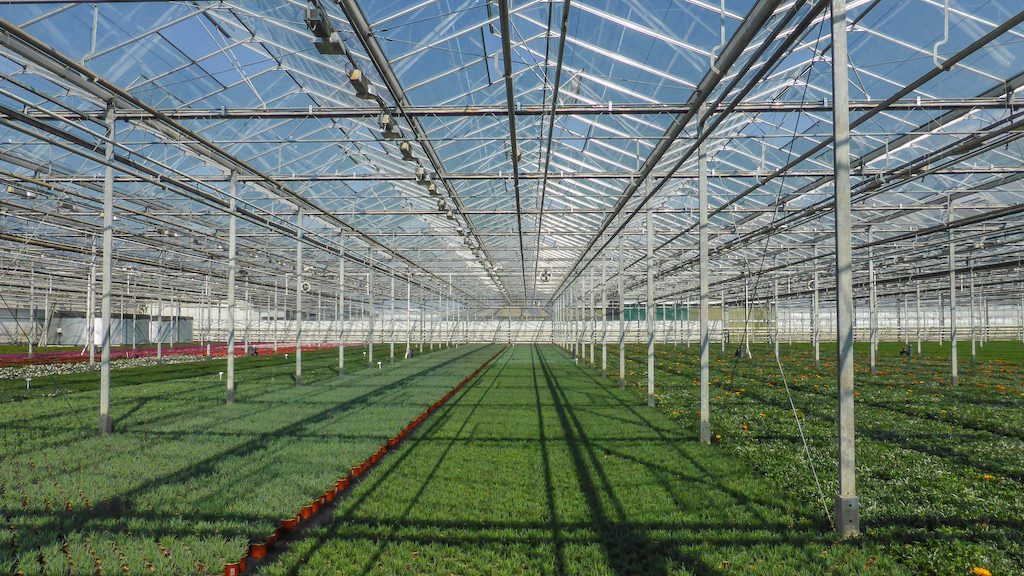Geothermal key element of sustainable choices for greenhouse horticulture

Making greenhouse horticulture more sustainable is possible shown by a study in the Netherlands looking at different scenarios based on four scenarios that all highlight the important role of geothermal energy for heat in this context.
A recent article in Dutch greenhouse horticulture publication groenten & fruit, maps sustainable greenhouse horticulture choices. Four different developments show these choices that could help making greenhouse horticulture more sustainable.
The scenario study into the sustainability of (among others) greenhouse horticulture is an exploration of the required infrastructure. In four scenarios, this still results in significant differences in the use of geothermal energy and heat storage in greenhouse horticulture. The use of biomass is also not fixed in those scenarios, according to the study Climate Neutral Energy Scenarios 2050 (in the Netherlands).
The study marks the beginning of the next phase of elaboration of the (country’s) Climate Agreement: choices in infrastructure that will be made this year.
Alternatives to CO2 pipe
For example, the researchers at the Berenschot and Kalavasta agencies argue about infrastructure that the supply and use of CO2 in greenhouse horticulture ultimately means CO2 emissions.
The current advantage of the CO2 pipelines is in the reduction of energy consumption in greenhouse horticulture, but this benefit will decrease if the sector switches to geothermal and electrification.
The researchers write about the reuse of CO2: “However, since CO2 is ultimately emitted in this sector, this means that negative emissions must be achieved elsewhere in the Netherlands. Another option is to use captured CO2 from green gas or biomass. ”
The use of electricity in greenhouse horticulture will grow by 3% per year until 2050. As a result, the heat required will decrease by 1% per year until 2050. That year, up to 60% of the heat demand can be met by geothermal energy.
The use of this geothermal energy is best utilized if sustainability is controlled regionally or via the national government. Those are two of the four scenarios now on the table.
In the other two scenarios (European or international control of sustainability), geothermal energy is used less (40% of the heat requirement in 2050 instead of 60%).
The use of heat pumps is 0 with regional control, but increases with control at national or European level. This is due to the greater emphasis that these governments place on electrification.
Four scenarios
1. Regional management
In the regional scenario, major efforts will be made on geothermal energy and heat networks. This provides a stable basic supply and can connect to the regional heat networks. As a peak / back-up, there are biomass boilers and green gas boilers in which possible biomass from the cultivated crops can be processed or supplied from the region. In addition, there are also green gas / biomass boilers in places where no geothermal energy is available. The region also provides for the supply of these green gas / biomass flows.
2. National management
The national government is investing extensively in geothermal energy for the horticultural sector. Because geothermal energy is easier to realize in horticulture than in the built environment, the full potential is utilized. As peak / backup capacity, there are biomass boilers, which are supplied with biomass that is collected nationally. In addition, because the government focuses on electrification, more use is made of heat pumps with thermal storage. A small percentage of CHPs remain on green gas, because they make a useful contribution to balancing the regional electricity supply.
3. European CO2 control
In this scenario, only half of the potential of geothermal energy is used, because the government and citizens are only willing to invest to a certain extent. Geothermal energy is only used in places where it is profitable. The peak and backup facilities are realized by biomass boilers, available through large biomass import flows. Most of the heat is generated by heat pumps with thermal storage.
4. International management
In this scenario, only half of the potential of geothermal energy is used, the government and citizens are only willing to invest to a certain extent. Geothermal energy is only used in places where it is profitable. The peak and backup facilities are realized by biomass boilers, available through large biomass import flows. In addition, a large percentage of heat is generated from heat pumps with thermal storage. A significant percentage of CHPs also remain on green gas, which also supply electricity.
Source: Groenten & fruit